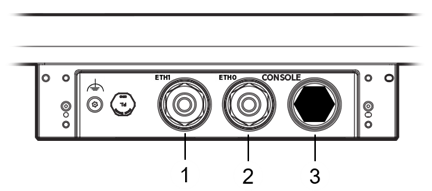AP5050D Features
The following list shows the AP5050D hardware features. Use this
information to further your understanding of the AP5050D technical specifications and
features.
Consult the following illustration for information on the AP5050D side ports. For more information,
see the Universal Wireless AP5050U and AP5050D data sheet.- Radios:
- Tri-radio design 2.4
GHz (4x4:4), 5 GHz (4x4:4) and 6 GHz (4x4:4)

Note
The 6 GHz radio is disabled until Automated Frequency Coordination (AFC) regulations are ratified. The access point is for outdoor deployment only at initial release. - One IoT Radio (BLE/802.15.4)
- Tri-radio design 2.4
GHz (4x4:4), 5 GHz (4x4:4) and 6 GHz (4x4:4)
- Two Ethernet ports (ETH0 and
ETH1):
- ETH0 is 1 x 100/1000/2500/5000 Mbps auto-negotiation Ethernet port, RJ45 (Power over Ethernet - PoE)
- ETH1 is 1 x 100/1000/2500 Mbps auto-negotiation Ethernet port, RJ45 (PSE)
- Dimensions: 11.3 in. x 18.8 in. x 2.9 in. (288 mm x 478 mm x 75 mm)
- One dual LED
For LED activity description, see AP5050D Status LED Activity Description.
- 3 mm diameter safety hanger provision
- Power: PoE 802.3at and 802.3bt: PSE enabled with 4x4x4
-
For complete power profile information, refer to the AP5050U power profile.
- Antenna:
- Two software selectable internal antennas (30 degree and 70 degree directional antennas)
- Temperature:
- -40°C to +60°C (-40°F to +140°F) operating temperature
- -40 °C to +70 °C (-40 °F to +158 °F) storage temperature
- Enclosure: Plastic top enclosure and aluminum bottom
-
One micro USB console port for troubleshooting or debugging issues
You can order a micro USB console adapter for your access point using the part number ACC-WIFI-MICRO-USB.
AP5050D Side Ports

| Callout | Description |
|---|---|
| 1 | Eth1 is 2.5/1GE/100 with PoE power sourcing equipment (PSE) 15.4W when 802.3bt on Eth0 |
| 2 | Eth0 is 5/2.5/1GE with Power over Ethernet (PoE) |
| 3 | Console port for troubleshooting |

